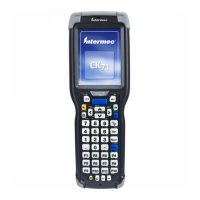
Do you have a question about the Intermec CK71 and is the answer not in the manual?
Introduces the Intermec 70 Series Mobile Computers, their models, and general characteristics.
Details new features and information added in the current version of the user manual.
Lists the standard features included in the 70 Series mobile computers.
Explains the location and function of status LEDs on the computer.
Lists and describes available accessories for the 70 Series computers.
Provides information on the rechargeable Lithium-ion battery packs used.
Instructions on how to fully charge the battery before first use.
Describes the different keypad layouts and backlight behavior.
Explains the touch-friendly user interface of Windows Embedded Handheld 6.5.
Details supported gestures for screen interaction using finger or stylus.
Explains the meaning of various icons displayed in the Title bar.
Introduces useful Intermec applications for configuration and connectivity.
Lists Intermec applications available on the computer.
Describes the phone capabilities and cellular technologies supported.
Provides instructions for activating the UMTS phone using a SIM card.
Details the process for activating the CDMA radio module with a carrier.
Explains how to use the Carrier Selection application to change carriers.
Describes the location and use of the computer's camera.
Explains how to configure basic and advanced camera settings.
Instructions for capturing still images using the camera.
Instructions for recording video clips using the camera.
Explains the use of the GPS Intermediate Driver (GPSID) for GPS hardware access.
Provides guidance on optimizing GPS performance using the iGPS application.
Outlines various methods for configuring computer parameters and settings.
Details how to use Intermec Settings for application and device configuration.
Instructions for enabling and configuring Wi-Fi radio communications.
Explains the five types of security for wireless networks and recommended implementations.
Compares Microsoft and Funk security options for wireless network preferences.
Discusses managing multiple devices using SmartSystems Foundation or third-party software.
Explains using CloneNGo for copying settings and parameters between computers.
Details managing devices via the SmartSystems platform from a central server.
Guidance on using Intermec Resource Kits to develop and install applications.
Methods for updating the operating system and system software using bundles.
Explains the Intermec Dashboard for proactive monitoring and diagnostics.
Provides troubleshooting tables for common computer issues.
Offers solutions for problems related to the 802.11 radio connection.
Addresses issues related to 802.1x security preventing network connection.
Provides solutions for problems encountered when reading bar codes.
Instructions for performing a clean boot to resolve computer lock-ups.
Details physical dimensions and environmental operating conditions for the computers.
Provides information on battery type, capacity, and electrical ratings.
Lists all supported bar code symbologies for the imagers.
Provides typical and minimum reading distances for various imagers.
Lists the default values for supported configuration settings.
Explains how to enter standard characters and functions via the keypad.
Details character and function entry for CN70 keypads.
Details character and function entry for CN70e keypads.
Details character and function entry for CK70 keypads.
Details character and function entry for CK71 keypads.
Provides bar codes to enable the 802.11 radio and set security defaults.
Bar codes for configuring the radio using a 2D imager (EA30 or EX25).
Bar codes for configuring the radio using a 1D imager (EV12).